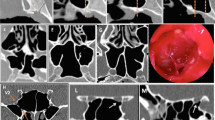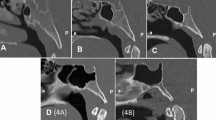Abstract
Recently, the endoscopic transsphenoidal approach for sphenoid sinus or intracranial lesion has gained more popularity and the study of the surgical anatomy and relationships of the sphenoid sinus has gained increased significance. The aim of this study was to clarify the anatomical features of the sphenoid sinus including surrounding structures as seen in the operative view of endoscopic transsphenoidal surgery. The various distances in the sphenoid sinus as well as the relationships between the sphenoid sinus ostium (SO) and important structures such as the optic canal (OC) and carotid artery (CA) according to the presence of Onodi cell (sphenoethmoidal cell; Onodi group vs. non-Onodi group) were assessed using multiplanar and three-dimensional model of CT scans in 100 patients. The SO was more inferior in Onodi group and located superior to the lowest point of the sella. The horizontal distance from the SO to sella was approximately 13 or 14 mm depending on the existence of Onodi cells. Regardless of Onodi cell, the whole course of the OC in the sinus ran superolaterally to inferomedially in the endoscopic view. However, Onodi cell made the angles from the SO to OC larger. In Onodi group, the CA was located from the SO in a superolateral direction, but in non-Onodi group, the CA was located from the SO in the inferolateral direction. This study provides anatomical information about the sphenoid sinus, with important surgical distances between the SO and surrounding structures measured, which is essential to avoid complications during transsphenoidal surgery.



Similar content being viewed by others

References
Hewaidi G, Omami G (2008) Anatomic variation of sphenoid sinus and related structures in Libyan population: CT scan study. Libyan J Med 3(3):128–133. doi:10.4176/080307
Sandulescu M, Rusu MC, Ciobanu IC, Ilie A, Jianu AM (2011) More actors, different play: sphenoethmoid cell intimately related to the maxillary nerve canal and cavernous sinus apex. Rom J Morphol Embryol 52(3):931–935
Wu HB, Zhu L, Yuan HS, Hou C (2011) Surgical measurement to sphenoid sinus for the Chinese in Asia based on CT using sagittal reconstruction images. Eur Arch Otorhinolaryngol 268(2):241–246. doi:10.1007/s00405-010-1373-1
Fukushima T, Maroon JC (1998) Repair of carotid artery perforations during transsphenoidal surgery. Surg Neurol 50(2):174–177
Shin JH, Kim SW, Hong YK, Jeun SS, Kang SG, Cho JH, Park YJ (2011) The Onodi cell: an obstacle to sellar lesions with a transsphenoidal approach. Otolaryngol Head Neck Surg 145(6):1040–1042. doi:10.1177/0194599811418040
Wang SS, Xue L, Jing JJ, Wang RM (2012) Virtual reality surgical anatomy of the sphenoid sinus and adjacent structures by the transnasal approach. J Craniomaxillofac Surg 40(6):494–499. doi:10.1016/j.jcms.2011.08.008
Enatsu K, Takasaki K, Kase K, Jinnouchi S, Kumagami H, Nakamura T, Takahashi H (2008) Surgical anatomy of the sphenoid sinus on the CT using multiplanar reconstruction technique. Otolaryngol Head Neck Surg 138(2):182–186. doi:10.1016/j.otohns.2007.10.010
Hwang SH, Joo YH, Seo JH, Kim SW, Cho JH, Kang JM (2011) Three-dimensional computed tomography analysis to help define an endoscopic endonasal approach of the pterygopalatine fossa. Am J Rhinol Allergy 25(5):346–350. doi:10.2500/ajra.2011.25.3638
Sikand A (2011) Computed tomography-based exploration of infundibular anatomy for maxillary sinus balloon dilation. Ann Otol Rhinol Laryngol 120(10):656–662
Gupta T, Aggarwal A, Sahni D (2013) Anatomical landmarks for locating the sphenoid ostium during endoscopic endonasal approach: a cadaveric study. Surg Radiol Anat 35(2):137–142. doi:10.1007/s00276-012-1018-8
Tomovic S, Esmaeili A, Chan NJ, Choudhry OJ, Shukla PA, Liu JK, Eloy JA (2012) High-resolution computed tomography analysis of the prevalence of Onodi cells. Laryngoscope 122(7):1470–1473. doi:10.1002/lary.23346
Cho JH, Kim JK, Lee JG, Yoon JH (2010) Sphenoid sinus pneumatization and its relation to bulging of surrounding neurovascular structures. Ann Otol Rhinol Laryngol 119(9):646–650
Feng Y, Zhao JW, Liu M, Wang TJ, Qi ZP, Wang XT, Ling LM, Gao L, Hou S, Chang S, Feng JC, Wang YF, Li YQ (2012) Internal carotid artery in the operative plane of endoscopic endonasal transsphenoidal surgery. J Craniofac Surg 23(3):909–912. doi:10.1097/SCS.0b013e31824ddf07
Conflict of interest
All authors have no financial relationship concerning present study.
Author information
Authors and Affiliations
Corresponding author
Rights and permissions
About this article
Cite this article
Hwang, S.H., Joo, Y.H., Seo, J.H. et al. Analysis of sphenoid sinus in the operative plane of endoscopic transsphenoidal surgery using computed tomography. Eur Arch Otorhinolaryngol 271, 2219–2225 (2014). https://doi.org/10.1007/s00405-013-2838-9
Received:
Accepted:
Published:
Issue Date:
DOI: https://doi.org/10.1007/s00405-013-2838-9



